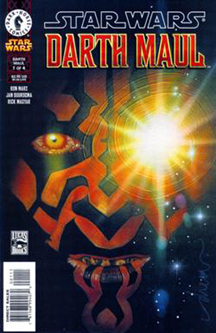On my initial viewings of “The Phantom Menace,” it struck me as odd that Qui-Gon and Obi-Wan refer to Darth Maul as “it,” rather than “he.” But that pronoun makes sense if you consider (as we learned in the 2012 novel “Darth Plagueis”) that Maul was trained by Darth Sidious from infancy to be a Jedi-hating killing machine. The idea of Maul as a biological machine was never more clearly illustrated than in the four-issue comic series “Darth Maul” (2000).
Other works have painted a fuller picture of Maul. I understand Ryder Windham’s young-adult novel “The Wrath of Darth Maul” (2012), which I haven’t read, tells the Zabrak’s whole life story as we knew it up to that point. And the last time we saw Maul in “The Clone Wars,” he was being betrayed by Sidious, who attacked him with Force lighting. Although Maul has always been portrayed as cold – even in his brotherly relationship with Savage Opress, it’s notable that Savage is the only one who regularly uses the term “brother” – the Sidious betrayal humanized Maul just a smidge. As viewers, we kinda-sorta felt bad for him.
But that’s all later in the timeline. In Ron Marz’s sparse-but-efficient (befitting the character) “Darth Maul,” the title character – following Sidious’ latest instruction to remove potential obstacles to his power grab — cuts through Black Sun vigos like a knife through butter. The vigos fear Maul as if he’s the Devil incarnate (which is certainly the case visually, as artist Jan Duursema gives us a shirtless, fully red-and-black tattooed Maul), but the Devil has more mood swings, doesn’t he? Sure, anger is a primary emotion of Maul’s, but in true Dark Side fashion, he hones that anger into a focused weapon. The purest characterization comes in Issue 4: A telepath looks inside Maul’s mind, grimaces, has a nose-bleed and mutters “so dark …” with a horrified expression before Maul kills him. Good stuff.
“Darth Maul” is a calling card for Marz and Duursema, both doing their earliest “Star Wars” work (aside from Duursema penciling Marvel Issue 92, “The Dream”) in what would turn out to be prolific careers. You’d be hard-pressed to find a “Star Wars” comic where less stuff happens than in Issue 1, where Maul destroys a bunch of robots in a sparring session (a precursor to Vader doing the same thing in “Shadows of the Empire”) and gets loaded up with tech and weaponry by his master – the Sith Infiltrator, its onboard speeder bike and a hefty supply of dark-eye probe droids.
In the latter three issues, Maul finds Black Sun HQ and kills every last vigo, plus the boss and the boss’ assistant, a Dathomiri Nightsister. It was cool stuff at the time, but it gains an extra layer of intrigue considering what we learned about Maul when he returned on TV’s “The Clone Wars.” This exchange is perhaps apocryphal after “The Clone Wars” revealed that Maul is a Dathomiri Nightbrother: “Do you know what I am? …You’ve never faced my kind before,” the Nightsister taunts Maul. “No, you’ve never faced MY KIND before,” Maul replies.

Maul shrugs off the Nightsister’s Force lightning and kills her, which is ironic considering that Sidious’ Force lightning fells Maul in “The Clone Wars,” although we can assume Sidious is much more powerful than the Nightsister. Even more ironic is the fact that Maul wipes out Black Sun’s leadership in this comic series. So when Maul joins Black Sun in “The Clone Wars,” those leaders arguably owe their ascension in the ranks to Maul himself – although they don’t know it.
In an example of purposeful continuity, the final panel seems to lead in to the 2001 Michael Reaves novel “Darth Maul: Shadow Hunter”: “I have another task for you, Lord Maul,” Sidious says. “There exists one more threat to our security.”
Through the years, storytellers have continually found “one more threat” for this biological machine to eliminate – two Maul short stories appeared in the 2012 re-release of “Shadow Hunter,” and earlier this year, Joe Schreiber put out the pre-“Episode I” novel “Maul: Lockdown.” While Maul was always champing at the bit to reveal himself to the Jedi, EU storytellers haven’t skimped on revealing more of Maul to readers. This comic series might not boast the richest story, but it is the purest example of Darth Maul being Darth Maul.

